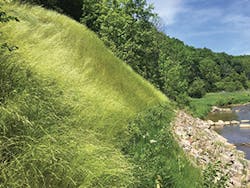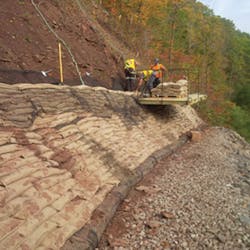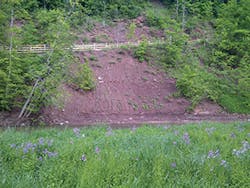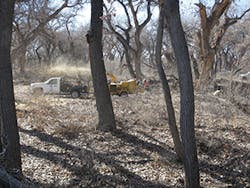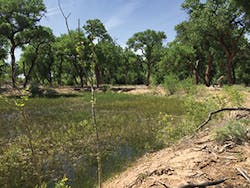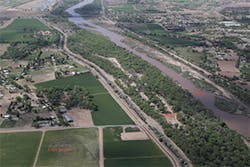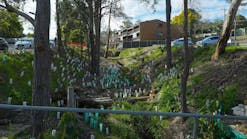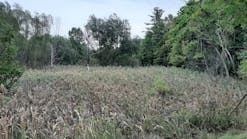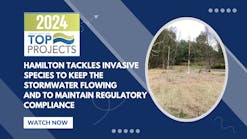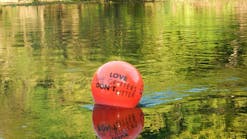The Benefits of Engineered Soils
Engineered soil: it sounds like a new concept, but one historical record notes it is more than 1,000 years old. In the sixth century AD, a group of ascetic monks left the lush, green mainland of Ireland seeking a new, remote environment to practice their dedication and humility. Braving the North Sea, they landed on Skellig Michael, “bristling lava cliffs and wrinkled glaciers coming down to the sea,” which could not have offered a more challenging opportunity for survival. Scoured by glaciers in earlier millennia, it was a punishing environment where little grew. The monks created arable soil by mixing sand and seaweed on the limestone karst, enabling them to grow vegetables. It worked, and the concept spread; the practice of mixing sand and seaweed to grow potatoes persisted through the 1700s.
While soil has long been another word for dirt, today’s sophisticated technology reveals the stuff under our feet to be a much more complex and vital environment than we ever dreamed. In its healthiest state, soil is teeming with beneficial life forms. It has an amazing capacity to retain water that sustains life during drought, it can prevent erosion by nurturing well-established root systems, and it stores carbon over long periods, helping to balance greenhouse gases.
Essentially, healthy soil is no less crucial than clean air and clean water, says soil specialist Ray Weil, professor of environmental science at the University of Maryland and author of The Nature and Properties of Soil. A lead speaker at a Maryland Commission on Climate Change working group meeting, Weil says that an increase in soil organic matter (SOM) from controlled grazing can, with the use of composts, manures, and appropriate nitrogen levels, all add to the soil carbon content.
“When cover crops and no-till management practices
are combined, these have a synergistic effect to dramatically raise the level of soil carbon and ultimately create a superior soil quality,” he says. “When soil quality is optimized with diverse rotation, we see greater quantity and quality of residues that enhance microbial activity, allowing plants to establish more quickly, and with robust and extensive root systems. All this fosters a stable, drought- and disease-
resistant soil environment.”
Soil as Nature Intended
At Idaho-based Alpha Nursery and Garden Center, owners Sue and George Wisbey say their motto is their mission: “Growing as nature intended.” She enthusiastically echoes Weil’s affirmation that soil quality is the direct link to productivity, sustainability, and climate change mitigation. In a recent pilot test on a 9-acre plot of primarily turfgrass, the application of an organic soil amendment cocktail mix called Alpha Three Complex (ACT-3) produced results in just one year that “are no less than spectacular.”
Wisbey’s client, River Ranch in McCall, ID, is an upscale home development whose owner offered the plot to Wisbey so she could test organic soil products Biosol, Menefee Humate, and mycorrhizae on one area and compare results to an area that was chemically treated.
“The first thing we did is test for pH, and it was pretty low, 6.0. So we put an application of dolomite lime on it to bring up the pH, then we put down the organic products in June, the end of July, and in late November of 2016 as a repellent treatment for voles. A couple of things happened,” says Wisbey.
She first describes the problems faced by area growers and turf owners who are plagued by voles, “a sort of a cross between a mole and a mouse that is a vegetarian and loves to eat plant roots.”
“You can see lawns, golf courses, and properties where there are trails of dead grass that the little critters leave behind as a calling card,” she explains. But she discovered that adding Biosol has a distinctive and positive side-effect: deterring voles.
“Here you have an organic fertilizer that also doubles as a pest deterrent. We’re not sure why, but the voles don’t like any soil treated with Biosol and they stay away; if anything, they only eat the tops of the grass, which is okay because the roots are still intact,” says Wisbey.
The Glenorchy Trail before restoration
She says the River Ranch owner sent a drone out over the property to show the before and after results from the amendment applications, and there was clear evidence “that the lines where vole damage had occurred had been filled in.”
But there was another obvious benefit, adds Wisbey. “The grass was greener for an extra two months, which helped their sales efforts. The untreated portions went brown much earlier and stayed that way much longer this spring.
“In Idaho we don’t have a long growing season, and after the cold ends it takes a bit for the grass to green up. But in this case, the grass stayed greener longer last fall and already was greening up in March and April 2017. From a business standpoint, the treatment is a good investment—you can take customers out to an aesthetically nice-looking site in late winter that’s already green and not crisscrossed with vole damage. Or you can keep a turfgrass facility like a golf course open longer.”
Wisbey says the 9-acre test area has in just one year reached a pH of 6.8, slightly shy of the ultimate goal of 7. She remarks that proper pH “has been a 15-year struggle to achieve for two local golf courses who typically use chemical treatments, but really, they are no closer to their goal now than they were when they started.”
She adds, “Once you use organics to correct soil, the soil is healthy naturally; it self-regulates its own pH, and it takes less intervention to keep it healthy.”
The application process for the Alpha Nursery experiment at River Ranch included 50 pounds of Biosol for every 2,000 square feet, one 50-pound bag of Menefee Humate for every 10,000 square feet, and one pound of mycorrhizae spores for every 1,000 square feet.
“This was the formula that we applied to get it up and running. We only need to fertilize two times a year. One application will be late summer, and then one in late spring because the microbial activity doesn’t really get going until the soil reaches a temperature of 45 degrees and all freezing is over.”
Wisbey describes how each constituent works. “The humate has carbon and humic acid that breaks down the organics in soil. This acts as an organic chelator, which converts into nitrogen for the roots, allowing the microbes in the Biosol, which are the byproduct of natural fermentation of sorghum, to deliver the nutrients that benefit the plant.”
She explains how the other element—mycorrhizae, natural fungi—works and what happens when the spores in the soil come into contact with plant roots. “The plants can actually communicate with the hyphae—those are the filaments of the fungus in the soil. When plant roots come into contact with the mycorrhizae, they recognize it as a beneficial organism and allow the mycorrhizae to attach to the root part of the plant. In a kind of complex molecular process the plant and this organism literally ‘talk to each other,’ and a symbiotic relationship is established. For example, the roots send out a message that the plant is low in boron, calcium, or some other element, and the mycorrhizae send out filaments in the soil to find what the plant needs and then deliver it back to the roots.”
At the Maryland conference, Weil cited one study from researchers in Germany who used electron microscopy to examine the activity of the fungi and found hyphae as far as 1,200 feet from plants they were attached to.
“This incredible communication system is the reason these plants look so healthy,” says Wisbey. “It’s because they are getting what they need.” And when plants are healthy, the soil aggregate surrounding the roots achieves the small particulate size so desirable for a root system to thrive and hold moisture, resist drought, fight off insects, and deliver more oxygen to the environment.
Although Wisbey concedes the products are more expensive to apply initially, she says, “Once you get into the program, your costs decline because you are creating an optimum environment with each application. The pH improves, the soil improves, earthworms and microbes proliferate to advance soil health. The roots are holding nutrients, and there is less runoff. If you have drought or low rainfall, these plants are more likely to survive and withstand the environmental pressures of wind, heat, and cold.”
In her analysis, her program compared to application of chemical fertilizers on a 2,000-square-foot turf with plantings was about three times more the first year, $150 versus $50. But in the following years the costs were about the same but with substantially better outcomes and benefits over chemical treatments in terms of self-adjusting pH; no required thatching; nearly double the flower, garden produce, shrub, and grass production; and better disease, insect, and drought resistance.
“The less expensive treatment comes at a price, and it’s not cheap. It’s more than the product in a bag you pay for. There’s the labor to apply them repeatedly, the carbon footprint needed to convey the chemical product for delivery, and costs of extra water, pest, and disease treatments. And the results are not sustainable. Our treatment approach offers superior results in growing and overall soil and environmental improvements.”
While many people are reluctant to “go organic,” Wisbey says the evidence from the River Ranch 9 acres might help them justify the expense, since by the second year the soil is so well established there is a need to fertilize only twice a year rather than four or five times a year.
Happy Trails Once Again
In Oakville, ON, a town near Toronto, Canada, town officials were concerned about erosion on the popular hiking and biking Glenorchy Trail system. The trail is located on a steep slope with subsurface of clay shale—the result of glacial scouring that created the nearby Great Lakes—and remediation posed a significant challenge.
After Envirolok presented its proposed solutions to the specifying engineer Amec Foster Wheeler, the proposal was accepted by the Town of Oakville and approved by the Halton Conservation Authority (one of 31 conservation authorities in the Province of Ontario), says Envirolok spokesperson Jay Morgan. He explains that the company won the contract to implement a solution using its mechanically stabilized earth wall system.
“The Glenorchy Trail is a well-used trail system within the 400-hectare Glenorchy Conservation Area, which is adjacent to the East Sixteen Mile Creek. Over time, the scouring action of the creek removed material from the slope walls, preventing the slope from reaching a stable inclination. Something had to be done, and fast, but it had to be a technique that was not a band-aid solution and would serve to support the slope for a very long time using an environmentally friendly, mechanically stabilized soil containment system—a soft mechanical process,” explains Morgan. He adds that Environment Canada specifies these types of restorations and mandates seed species, types of soil, and types of engineering used for public spaces.
With the region receiving several feet of snow each year, Morgan says Mother Nature throws obstacles toward maintaining integrity of the trail, including heavy rains.
“We’re getting fewer rain events, but each one is a deluge and more intensified; plus we have snowmelt and the subsequent erosion, and the steep slope that limits access for repairs.”
To manage the restoration, the company used 4,500 Envirolok bag units and installed live-staked dogwood and willow into the bags, then hydroseeded with a native seed mix approved by the local Ontario conservation groups.
“This project was 450 square meters. If we were to backfill and use geogrid, it would have taken much longer and been more disruptive to the environment, and far less a soft, green solution.
“To address the limited work area, we had the bags filled offsite and then delivered to the park, and it was all done in about five days with minimal disturbance.”
Company spokesperson Eric Seidl says Envirolok is a manufacturer of vegetated mechanically stabilized earth (MSE) wall systems providing a permanent, sustainable, and aesthetic solution for a variety of soil stabilization, shoreline protection, stormwater, and erosion control applications.
Envirolok is a wholly owned subsidiary of Agrecol. “We collaborate with a variety of clientele, including regulatory agencies, landscape architects, civil engineers, and contractors who come to us looking for a natural and cost-effective solution,” says Seidl. “Envirolok units consist of a tan, nonwoven geotextile bag, two connector pins or ‘spikes,’ and a bag tie. The spikes connect the Envirolok bags together and provide shear strength for wall and embankment applications. By vegetating the bags, plant roots work in unison with the strength of the Envirolok structure to create a long-term solution.”
Clearing invasive species and debris for a swale at Valle de Oro in 2014
Morgan notes, “They are more environmentally friendly from a carbon footprint standpoint, and they create the kind of habitat to attract local birds, butterflies, small native wildlife like otters, beavers, and fox. People using the trail like to come here and enjoy the outdoors and a natural environment—not to look at concrete.”
Once the bags are filled with an engineered soil mix (80% sand and 20% topsoil), they are approximately 26 inches long by 15 inches wide by 5.5 inches tall. He adds that because of their malleable soil structure, they are easy to install, requiring a less intensive base course than traditional MSE walls. “The flexibility of the bags also makes it easier to work with the natural contours of the land, and tends to have less impact due to construction,” he says.
“When we are dealing with extreme water velocities and wave action in riparian corridors, we typically recommend a course of riprap below the scour line, or filling bags that are below the ordinary high water mark with a clear gravel,” says Seidl.
Because many of the Envirolok project sites have limited access due to waterways and extreme slopes, “We are seeing many contractors filling the bags with engineered soil prior to transporting them to the site.”
Seidl also says that in more decorative applications, such as low retaining walls or raised planters, native or excavated topsoil from the site can be used, but must be free of debris and contaminants.
“Although many ornamental landscape plants will work with the Envirolok system, we will recommend plant species locally native to each project as they tend to have deep root systems that create additional structural reinforcement in the soil and help uptake and filter water.”
Once the bags are installed, they can be vegetated with hydroseeding, plant plugs, or live stakes.
Seidl says the company is seeing an increasing number of projects specifying Agrecol’s Native Vegetated Mat (NVM), which he describes as “a great way to provide instant cover for slopes and waterway banks prone to erosion.”
Agrecol provides a variety of pre-designed vegetated mats, such as a “Short and Showy” mix and “Rainwater Renewal” mix. NVM can also be custom designed with native grass and forb species to meet specific site conditions and maintenance needs. Through Agrecol’s southern Wisconsin location with 1,000 acres of growing fields and over 60,000 square feet of greenhouse, Seidl says, the company is able to grow over 450 species native to the Midwest and the Great Lakes Region.
“For example, prairie dropseed is a favorite native grass that we see used quite often. Its short stature, two to three feet tall, and fine texture lends itself as a great accent and filler. When blooming, the flowers have a wonderfully aromatic cilantro-like smell to them. Prairie dropseed is often companioned with little bluestem and various wildflowers, such as prairie smoke, butterfly weed, and black-eyed Susan, creating natural habitat with four seasons of visual interest.”
The company also sees the best establishment of vegetation when combining hydroseeding with native plant plugs or live staking riparian species such as dogwoods and willows. He says that by the second growing season, the Envirolok bags are no longer visible due to the growth of vegetation.
“The key to any successful planting is species diversity and selecting species that are reflective of context and microclimate,” says Seidl. “There are so many unique native plants that can play a critical role in soil development by increasing nitrogen, adding biomass, natural aeration from roots, and even uptaking contaminants.”
The Glenorchy trail project was so successful it won the 2016 project of the year award from the Ontario Public Works Association.
“This kind of new, low impact development is the way to go, and our Envirolok system is adaptable with the freeze-thaw cycle up here. It’s a natural solution, and people really like that,” says Morgan.
Lady Liberty Approves
When Hurricane Sandy roared up the east coast leaving a trail of damage, Ellis Island and nearby Liberty Island took a direct hit. The historic gateway to the US was affected by huge flood surge that covered most of both islands, causing $27 million in damage. While the artifacts and collections had been for the most part spared, the islands’ exposure to being submerged under several feet of seawater left the soil saturated with salt, and remediation had to be addressed before any new plantings could be installed.
According to spokesperson Kristine Esdale, a targeted application of product from Massachusetts-based Solu-Cal USA played a significant role in repairing the storm-
damaged soil. The company produces a suite of soil improvement products. Its specialized soluble calcium, sulfur, and activated humic acid technology can raise soil pH or remediate high-sodium soils faster than traditional lime or gypsum products.
“Project EverGreen was tasked with the restoration of the 9/11 memorial on Ellis Island and the Statue of Liberty Enhancement project,” explains Esdale, “and we donated eight tons of Solu-Cal S Enhanced Gypsum to help repair the damages from Sandy.”
“One of the benefits of this product is that you can apply this for the salt remediation, but at the same time it does not change soil pH,” says Esdale. “Seedlings can develop better in ideal soil pH conditions, and by only flushing out excess sodium—but not adversely affecting the acid-alkaline balance—the soil can host the most hospitable environment possible for rapid renourishment and repair.”
The product helped to flush out the excess salt in preparation for the planting of trees and turf in the flood damaged area. She adds that EverGreen, a not-for-profit organization, was responsible for the donated services—removing dead and dying trees and the remedial treatment of the remaining damaged trees from the storm surge.
The work was completed in mid-2014. That same year the company’s Solu-Cal Enhanced Calcitic Lime was listed as approved for organic use by the Organic Materials Review Institute (OMRI). “A listing with OMRI is only granted to products that successfully undergo the institute’s rigorous product review and found to be in compliance with organic standards,” explains Esdale.
The same area at Valle de Oro in 2017. It takes
two to three years for native plants to take over from the invasives.
First of Its Kind and Gaining Ground
Most national wildlife refuges managed by the US Fish and Wildlife Service (FWS) are typically located in remote settings. Not Valle de Oro, says refuge manager Jennifer Owen-White, who boasts that the refuge “is the first of its kind, located right outside the city limits of Albuquerque.”
Owen-White says that the FWS has oversight of 560 national refuges across the US and its territories, and their mission “is one of protecting land, water, plants, and animals, and especially their unique habitats to ensure the species for current and future generations.”
She says, “Our site here is unique in that it is a new concept: a special urban refuge that connects the local community to the land and provides opportunity for people to become involved as stewards of the land.”
A newcomer to the family of wildlife refuge areas, Valle de Oro was officially established in 2012 following its acquisition from the local owners who ran a dairy farm for more than 50 years on the more than 700 acres. A large area is still being farmed for alfalfa hay, notes Owen-White, but as development plans proceed, this will change.
“They took the cows off in the 90s, but the dairy still owned the land, so when we purchased this property, including the water rights, it became the first-ever urban refuge.
“One of our major initiatives is getting the community involved to participate with the construction of our education centers and restoring the property back to its original state. They’ll be involved with the seeds, plants, and wildlife, and it will give people a chance to see what it’s like to take an abandoned farm and turn it around.”
Owen-White says Valle de Oro partners with another nearby refuge called Bosque del Apache. “They let us come and harvest some plants that are typical. We will have salt grasses that are highly tolerant of saline, which does well here, and bunch grass. Some of our other species include purple prairie clover, sand sage, blue grama, galleta, and Indian ricegrass.”
And “a river runs through it” is both accurate and significant to the refuge, as White explains the role of the Middle Rio Grande and its presence in Valle de Oro. “The Rio Grande is a protected waterway. It stretches from southern Colorado through New Mexico, becoming the border with Texas and Mexico, and then exits to the Gulf. But the Middle Rio Grande, the portion that encompasses a lot of Albuquerque, has a special environment.”
Called bosque, Spanish for forest, “This land area borders the river, and both sides are protected. It is a major migratory flyway, and in winter we get white geese, a lot of ducks in the summer, herons, egrets, curlews, and lots of raptors. And then there are coyotes, roadrunners, several owl species, and cranes.”
Several unique species of fish call the river home as well. Yet, at an altitude of 5,000 feet, the Middle Rio Grande in Albuquerque is different from other portions of the river.
“This is considered high desert, and the river flows right through the city; because of the altitude we have all this exceptional diversity.”
She adds that because of development and diverting of the river for human needs, seasonal flooding no longer occurs, as the dynamics of the river have been changed. “So now we have to try and recreate nature as it once was out here on the refuge.”
To achieve its goals of returning to a natural environment, the refuge works with several partners, including the Albuquerque Metropolitan Arroyo Flood Control Authority. Authority project engineer Lynn Mazur explains that arroyos are the natural flow paths that contain the waters from intense storms, which can create flash flooding.
Although the arroyos are dry for much of the time, “These can be very dangerous when water starts to collect and runs at high velocity of 30 miles per hour. People are warned to stay out of them as they can—and have been—swept away with loss of life.”
Building a bridge structure across an irrigation canal that connected the drainage outfall of the refuge with the adjacent river bosque was an undertaking Mazur cites as “a highlight of my career.” Before the bridge was built, it was difficult for workers to access the bosque, which had no direct connection to the overbank area of the river; the nearest access point was 3.5 miles away.
The project began with removing invasive species, such as elms and weedy plants. Crews removed “300 trees, many of them dead and dying, and we had to build ponds so there was lower elevation for the flood waters to drain to after the connection.”
The new bridge connection is now a big advantage for the public as well. “I’ve seen canoeists, bicyclists, and hikers using this bridge to access this part of the refuge and river. Elementary schools are taking kids out there to see the river and the bosque; some of them have never been in a wilderness setting. It’s all very gratifying.”
In the next five years, says Owen-White, she’d like to see her vision completed. This includes building of a visitors’ center, restoration of riparian habitat, and the conversion of the alfalfa pasture to native grasses. And the Middle Rio Grande will play a role in local water issues, too.
“We have an entire program that will coordinate with the City’s stormwater plan, so our presence will have a definite impact on local water quality and stormwater management.”
She adds, “In the next 10 years, I’d like to see the new grasses, plants, and trees all growing, and I’d love to see community members—those young middle school kids who helped plant the first trees—come back as college students, and then come back with their kids to enjoy this space. But what I want most is to develop a mindset of conservation and stewardship—the importance and connectivity of land, water, wildlife, and plants—to develop within our community so that these efforts today continue in perpetuity.”
As a success story, Valle de Oro could well herald a trend for FWS to initiate new projects in blighted urban areas.

